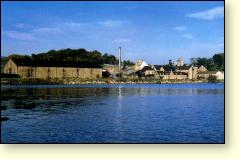
 |
|
Location: Alness, Ross-shire IV17 0UT
Roads: Off A9 north of Inverness
Hours: All visits by appointment only. Group bookings, max 10
No reception centre or shop
Phone: 01349-882362
|
Alexander Matheson was a partner in the dynastic Hong Kong trading firm, Jardine Matheson & Co. In the early days these merchants dealt in everything from tea to opium, the latter commodity the reason that the British took root there in the first place. In 1839, the very year that the First Opium War broke out between China and Britain, Matheson bought Ardross farm, on the shore of the Cromarty Firth near the village of Alness, and set about improving it; one of the facilities he added was a still.
Much of the whisky produced in Scotland in the 18th century came from Easter Ross and Dalmore was one of the new distilleries built in the area in the wake of the 1823 Act, which made distilling both viable and legal. The distillery sits in a beautiful spot on the shore of the Cromarty Firth north of Inverness.
During the early years the distillery was leased to the Sutherland family, with the lease then passing to Robert Pattison in the mid 1860’s. The tenancy then passed to the Mackenzie family in 1867, who eventually took ownership in 1891. Andrew Mackenzie was the moving force of the Mackenzie brothers and impudently included Speyside in their sales patch for Dalmore whisky. He was also something of a good cricketer, playing for a local team and usually able to put a good score on the board.
Ownership remained with the Mackenzies until 1960 when it was bought by the Glasgow based Whyte & Mackay Group.
Peat and barley were locally grown and coal to fire Dalmore’s stills came in to Alness station from the Fife colleries via the newly opened railway line. A single railway line used to connect the distillery with the main line at Alness station, which in the old days, was a rallying point for the Highlanders from the north against the Southerners.
This railway line enabled barley and coal etc. to be delivered direct into the premises. The pier at Belleport on the Cromarty Firth forms part of the distillery property and also allowed shipments of barley, coals, coke and other stores to be unloaded at its door from the steamers.
During World War 1, £1 million worth of maturing whisky was removed to three other distilleries in the area and Dalmore’s warehouses were requisitioned by the Admiralty as a mine-making factory, It was 1920 before the distillery was handed back and the whisky returned, with not a single cask missing.
Dalmore’s make figures in all the parent company’s blended brands and the Mackenzie connection is remembered on the Dalmore labels with the stag’s head emblem, the badge of the Mackenzie clan.
In 1956 a Saladin box system of malting was installed and operated until 1981, when malting production ceased.
The distillery acquired sole rights to draw its water from the River Alness which flows from the beautiful Loch of Kildermorie, close to Ben Wyvis. Production began with a single pair pair of stills and a second pair was added in a separate stillhouse in 1874. The upper part of those 1874 stills has survived and is still in use today. It is unusual in outline, having parallel sides instead of the customary tapering swan-neck. Dalmores’ stills are cooled by running water over the outside of the stillnecks in a way that is similar to the temperature control on fermentation vats in wine making. There are now four pairs of stills, the latter four units dating from 1966.
Dalmore covers 25 acres, much of that space taken up with the warehouses where the spirit matures. There are about 100,000 casks on site. The oldest whisky still mellowing there in wood is a 1939 distillation.
The Whisky
In Andrew Mackenzie’s day, there were two qualities. The better one was aged in sherrywood, the standard in new casks called distillery wood. The whisky was aged for up to six years and often the two styles were vatted together, the proportions depending on the customer’s taste. Today, large batches of casks with 12- to 15-year-old Dalmore are vatted (blended) and then kept in sherrywood until bottled.
The whisky is quite full in flavour but shows elegance of finish. A mite smoky, naturally dryish but showing sweet-edged because of the sherry background. Twelve-year-old and 40/43% vol.; the same age from different wood may be had from one of the independents.
Source of water
Alness river